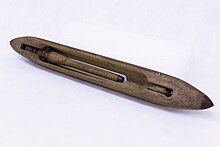|
Flying shuttle
  The flying shuttle is a type of weaving shuttle. It was a pivotal advancement in the mechanisation of weaving during the initial stages of the Industrial Revolution, and facilitated the weaving of considerably broader fabrics, enabling the production of wider textiles. Moreover, its mechanical implementation paved the way for the introduction of automatic machine looms. The brainchild of John Kay, the flying shuttle received a patent in the year 1733 during the Industrial Revolution. Its implementation brought about an acceleration of the previously manual weaving process and resulted in a significant reduction in the required labour force. Formerly, a broad-cloth loom necessitated the presence of a weaver on each side, but with the advent of the flying shuttle, a solitary operator could handle the task proficiently. Prior to this breakthrough, the textile industry relied upon the coordination of four spinners to support a single weaver. The widespread adoption of the flying shuttle by the 1750s dramatically exacerbated this labour imbalance, marking a notable shift in textile production dynamics.[1] HistoryThe history of this device is difficult to accurately ascertain due to poor documentation at the time. Nonetheless, there are two general schools of thought around this: first those that believe that it appears to have been invented in the region of Languedoc of southern France (one year before its introduction in England), but was destroyed by state cloth inspectors of the rent-seeking Ancien Regime;[2] second, those that believe it simply originated where it was industrialized, that is in England. Operation In a typical frame loom, as used previous to the invention of the flying shuttle, the operator sat with the newly woven cloth before them, using treadles or some other mechanism to raise and lower the heddles, which opened the shed in the warp threads. They then had to reach forward while holding the shuttle in one hand and pass this through the shed; the shuttle carried a bobbin for the weft. The shuttle then had to be caught in the other hand, the shed closed, and the beater pulled in against the fell to push the weft into place. This action (called a "pick") required regularly bending forward over the fabric. More importantly, the coordination between the throwing and catching of the shuttle required that the weaver was weaving narrow cloth (typically 60 inches (150 cm) or less). If the loom was for weaving broad cloth multiple weavers were needed: one on the left side at the shed, and one on the right side at the shed (and sometimes, one to operate the treadles). These two reached across the loom, passing the shuttle back and forth through the shed. The flying shuttle employs a smooth board, called the "race," which runs, side to side, along the front of the beater, forming a track on which the shuttle runs. The lower threads of the shed rest on the track and the shuttle slides over them. At each end of the race, there is a box which catches the shuttle at the end of its journey, and which contains a mechanism for propelling the shuttle on its return trip (which may be yanked into action by the cord from the handheld picking-stick, or fully automated) The shuttle itself has some subtle differences from the older form, especially for automated and powered looms. The ends of the shuttle are often bullet-shaped and metal-capped, and the shuttle generally has rollers to reduce friction. The weft thread is made to exit from the end rather than the side, and the thread is stored on a pirn (a long, conical, one-ended, non-turning bobbin) to allow it to feed more easily. Finally, the flying shuttle is generally somewhat heavier, so as to have sufficient momentum to carry it all the way through the shed.
Social effectsThe increase in production due to the flying shuttle exceeded the capacity of the spinning industry of the day and prompted the development of powered spinning machines. Beginning with the spinning jenny and the waterframe until ultimately culminating in the spinning mule, which could produce strong, fine thread in the quantities needed[3][4] these innovations transformed the textile industry in Great Britain. The innovation was seen as a threat to the livelihood of spinners & weavers, which resulted in an uprising that had Kay's patent largely ignored. It is often incorrectly written that Kay was attacked and fled to France, but in fact he simply moved there to attempt to rent out his looms, a business model that had failed him in England.[5] The flying shuttle produced a new source of injuries to the weaving process; if deflected from its path, it could be shot clear of the machine, potentially striking and injuring workers. Turn-of-the-century injury reports abound with instances in which eyes were lost or other injuries sustained and, in several instances (for example, an extended exchange in 1901), the British House of Commons was moved to take up the issue of installing guards and other contrivances to reduce these injuries.[6] ObsolescenceThe flying shuttle dominated commercial weaving through the middle of the twentieth century. However, by that time, other systems had begun to replace it. The heavy shuttle was noisy and energy-inefficient (since the energy used to throw it was largely lost in the catching); also, its inertia limited the speed of the loom. Projectile and rapier looms eliminated the need to take the bobbin/pirn of thread through the shed; later, air- and water-jet looms reduced the weight of moving parts further. Flying shuttle looms are still used for some purposes, and old models remain in use. References
|



